#Cayo Real Estate
Explore tagged Tumblr posts
Text
youtube
#luna realty belize#belize real estate#belize property for sale#ambergris caye#condo for sale in belize#belize city#waterfront property with stunning views for sale#secret beach belize#cayo real estate#Youtube
0 notes
Text
Discovering Cayo Real Estate Prices: An Essential Handbook for Investing in Belize
Hello there, fellow traveler! If you’re reading this, it’s safe to assume that the idea of investing in the tropical paradise known as Belize has crossed your mind. Specifically, you may be interested in the cayo real estate market, home to lush landscapes, diverse wildlife, and a burgeoning expatriate community. Continue reading>>
0 notes
Text
Belize Real Estate
Belize Real Estate
Belize is one of the hottest real estate markets in the Caribbean & Central America. Belize Real Estate has been booming over recent years as the country grows as a tourism and investment destination.
In Belize, we do not have a standard MLS which makes working with a Belize real estate professional and Belize real estate agent even more important. It also makes the job of a realtor different than what you are used to in other jurisdictions. A real estate agent can help you navigate the market and find the perfect investment property or home in paradise.
Certainly! Here's a piece of content using the term "Belize Real Estate":
Explore the Potential of Belize Real Estate
Belize Real Estate has become a sought-after investment opportunity for both seasoned investors and first-time buyers. With its tropical climate, pristine beaches, and stable economy, Belize is quickly gaining popularity among expatriates, retirees, and individuals looking for a second home or vacation property. Whether you're interested in beachfront properties, luxury condos, or rural farmland, Belize offers a wide variety of real estate options to suit diverse needs and budgets.
Why Invest in Belize Real Estate?
Stable Economy: Belize has a growing economy supported by tourism, agriculture, and real estate, making it an ideal market for real estate investment. With a stable political environment and friendly tax policies for foreign investors, it’s no surprise that Belize is becoming one of the top destinations for property purchases in Central America.
English-Speaking Country: Unlike many countries in the region, Belize’s official language is English, which makes navigating legal matters, conducting business, and everyday living much easier for international investors.
Low Taxes: Belize offers relatively low property taxes, making it an attractive place for those looking to maximize the return on their real estate investments. The country also has a favorable tax system for retirees, with the Qualified Retired Persons (QRP) program offering tax incentives to those who relocate.
Stunning Natural Beauty: Belize is home to some of the most beautiful landscapes in the Caribbean. From the stunning beaches of Ambergris Caye and Placencia to the lush jungles of the Cayo District, the country offers a range of real estate options that appeal to those seeking a peaceful, natural environment.
Growing Tourism Industry: With its thriving tourism industry, Belize has seen an increase in demand for vacation rentals and short-term rental properties, providing a steady stream of income for investors in the real estate market.
Key Areas for Belize Real Estate Investment
Ambergris Caye: Known for its stunning beaches and vibrant culture, Ambergris Caye is one of Belize's most popular tourist destinations. This island is home to luxury resorts, high-end vacation rentals, and beachfront properties that offer incredible potential for long-term value.
Placencia: Offering both beachfront and inland properties, Placencia is known for its laid-back lifestyle and beautiful coastline. It’s a popular area for expats and retirees looking for a more relaxed atmosphere without sacrificing access to amenities.
Corozal: Located near the Mexican border, Corozal is an up-and-coming area for real estate investment, especially for those looking for affordable land and homes. The proximity to Mexico makes it a convenient option for those seeking cross-border opportunities.
Cayo District: For those interested in more remote properties, Cayo offers a mix of jungle, farmland, and eco-tourism potential. This district is perfect for buyers looking to build sustainable homes or invest in agricultural ventures.
The Belize Real Estate Buying Process
Purchasing property in Belize is relatively straightforward. Foreigners can buy property in Belize without restrictions, though there are some limitations on land within a mile of the borders. It’s essential to hire a local attorney to navigate the legal aspects of buying property, including ensuring the title is clear and that all necessary documentation is in order.
The closing process typically takes 30 to 60 days, with standard costs such as stamp duty, legal fees, and registration fees. Financing is available through some local banks, though many buyers choose to pay cash for a smoother transaction process.
0 notes
Text
Belize Real Estate – Your Path to Caribbean Living
Introduction
Imagine a life where you wake up to warm ocean breezes, spend your days exploring vibrant coral reefs, and unwind with breathtaking sunsets over the Caribbean Sea. Belize, with its natural beauty and welcoming culture, has become a dream destination for those looking to experience the joys of Caribbean living. Thanks to affordable property prices, favorable foreign ownership laws, and a growing expat community, Belize Real Estate offers a unique pathway to making that dream a reality. Whether you’re searching for a retirement haven, a vacation retreat, or a lucrative investment, Belize has options to match every lifestyle.
Why Choose Belize for Caribbean Living?
There are many reasons Belize real estate is attracting people from around the world. Here are a few highlights:
Tropical Beauty and Diverse Ecosystems: From stunning beaches and turquoise waters to lush jungles and majestic mountains, Belize has a diverse range of natural wonders that appeal to anyone seeking a serene lifestyle.
English-Speaking: Belize is the only English-speaking country in Central America, which makes it easy for expats to communicate, navigate daily life, and conduct business.
Favorable Ownership Laws for Foreigners: Belize allows full property ownership for foreigners, meaning you can own land and property with the same rights as locals, including beachfront properties.
No Capital Gains Tax: Belize’s tax-friendly policies include no capital gains tax, making it a financially attractive destination for property investors.
Growing Expat Community: With a welcoming environment, Belize has developed a strong expat community, making it easy to connect with others who’ve chosen this tropical paradise for their new home.
Belize Real Estate Options for Caribbean Living
Whether you’re looking for a beachfront villa, a jungle retreat, or a condo in a lively community, Belize real estate has options for every lifestyle. Here are some of the popular types of properties:
1. Beachfront Homes
For those drawn to the sea, Belize’s coastlines and islands offer beautiful beachfront properties, particularly in areas like Ambergris Caye, Placencia, and Caye Caulker. Beachfront homes give you direct access to the ocean and the lifestyle perks that come with it—scenic views, water sports, and a relaxed pace of life.
2. Island Condos
Island living on Ambergris Caye or Caye Caulker offers easy access to restaurants, shops, and a vibrant community. Condos on these islands are popular with retirees and vacationers alike, providing modern amenities, rental income potential, and close proximity to the Belize Barrier Reef.
3. Jungle Retreats and Eco-Properties
If you love nature and adventure, Belize’s inland regions, particularly in the Cayo District, offer beautiful jungle properties and eco-friendly developments. These homes offer tranquility in lush landscapes filled with rivers, caves, and Mayan ruins, appealing to those seeking privacy and immersion in nature.
4. Affordable Properties in Corozal
Corozal, located near the Mexican border, is known for its affordable properties and peaceful environment. This area is particularly popular among retirees and those seeking a more relaxed lifestyle with lower property costs. With a bayside setting and access to amenities in Mexico, Corozal is a great option for budget-conscious buyers.
Steps to Start Your Journey to Caribbean Living in Belize
Step 1: Research the Market and Choose a Location
Each region in Belize offers its own unique lifestyle and real estate market. Spend time researching different areas and decide which one aligns best with your goals—whether that’s a beachfront lifestyle, island vibes, or a jungle escape.
Step 2: Work with a Trusted Real Estate Agent
Navigating Belize’s real estate market is easier with the help of a local agent who understands the nuances of buying property as a foreigner. Agents with experience in Belize real estate can guide you to the best listings, ensure transparency in transactions, and help you navigate legalities specific to Belize.
Step 3: Understand the Legal Process
Belize’s legal process for buying property is relatively straightforward, but it’s still important to understand the key steps:
Property Title Verification: Ensure the property has a clear title and no outstanding liens. Partnering with a Belizean attorney can provide peace of mind during this step.
Stamp Duty: Belize imposes a transfer tax of 5-8% on property purchases. Be sure to include this in your budget.
Property Ownership Rights: Belize allows foreign ownership with the same rights as locals, including for beachfront properties. You’ll have full legal rights over your land, unlike in many other Caribbean countries where land leases may be more common.
Step 4: Consider Property Management if Needed
If you’re purchasing Belize real estate as a vacation home or rental investment, hiring a property management company can be beneficial. Property managers in Belize can handle maintenance, bookings, and other responsibilities, making it easy to enjoy the benefits of your investment without having to manage it daily.
Step 5: Explore Residency Options
Belize offers the Qualified Retired Persons (QRP) program, which is an excellent option for retirees. This program allows retirees to live in Belize tax-free on foreign income, provided they meet certain requirements. To qualify, you must be over 45, have a monthly income of at least $2,000, and spend at least a month each year in Belize. This program is popular with expats who wish to make Belize their primary home while enjoying financial benefits.
Benefits of Belize Real Estate Investment
Investing in Belize real estate is not only a pathway to Caribbean living but also a sound investment with potential for growth. Belize’s real estate market is still developing, and with increasing tourism, property values are expected to appreciate over time. Furthermore, rental demand is high in popular tourist areas, providing an opportunity for steady income if you choose to rent out your property.
Additionally, Belize’s growing infrastructure, including better road networks, healthcare, and services, is enhancing the quality of life and adding value to the real estate market. This makes Belize real estate an appealing long-term investment for those looking to establish a lifestyle in the Caribbean.
Making the Most of Caribbean Living in Belize
Once you’ve secured your Belize property, you’ll find endless ways to enjoy Caribbean living. Here are just a few:
Water Activities: Belize is famous for its proximity to the Belize Barrier Reef, offering snorkeling, diving, and fishing in one of the most biodiverse marine ecosystems in the world.
Cultural Experiences: Belize has a rich cultural heritage, with influences from the Mayan, Garifuna, Mestizo, and Creole communities. You’ll find vibrant festivals, music, and local cuisine to enjoy.
Nature Exploration: Beyond the beaches, Belize’s natural landscapes offer waterfalls, jungles, caves, and nature reserves. Inland areas like Cayo District are ideal for hiking, birdwatching, and exploring ancient Mayan ruins.
Expat and Local Community: Belize’s expat community is warm and welcoming, making it easy to connect with others who share a love for the Caribbean lifestyle. Belizeans are also known for their hospitality, making it easy to feel at home.
Conclusion
Belize real estate is a gateway to a laid-back and fulfilling Caribbean lifestyle. With its beautiful landscapes, expat-friendly policies, and vibrant communities, Belize offers a unique blend of adventure, relaxation, and opportunity. Whether you’re planning to retire, invest, or simply enjoy a slice of paradise, Belize has the real estate options to turn your Caribbean living dreams into reality. By choosing the right property, working with a trusted agent, and understanding the local market, you’ll be well-prepared to enjoy the best that Belize has to offer. Dive into the Belize real estate market today and discover your path to Caribbean living.
1 note
·
View note
Text
Belize Real Estate
Belize is a gem in Central America. There is no comparison to the breathtaking landscape, cultural richness, and investment opportunities available in real estate, considering its coastal areas—Ambergris Caye and Placencia—with clear turquoise waters and beaches of white sand, would offer the best place for a beachfront lifestyle. Those who are after adventure can always go inshore to the dense jungle and Mayan ruins in the Cayo District. The country also harbors a high expat and retiree population, being an attractive place given friendly tax laws and an English-speaking society. Whether it is the search for a holiday home, retirement haven, or an investment property, Belize in real estate has something for everyone.
Perhaps more importantly, also boosting investment in real estate in Belize is the favorable tax climate of this country. It does not levy any capital gains tax, and the rates of property taxes are low. What is more, the government offers various incentives for such people to invest in tourism-related developments.
Ambergris Caye is one of the best places in the region to enjoy island life, with a vibrant expat community and a thriving tourism industry. San Pedro, Ambergris Caye, includes all the modern conveniences, quality dining, and nightlife to make it a great place to live and vacation. Meanwhile, Placencia is famous for its pretty beaches and relaxed surroundings—a perfect place for someone looking for a getaway from everything.
Inland, the Cayo District is stunning with its heavy rainforests, magnificent waterfalls, and key archaeological sites. Towns like San Ignacio and Belmopan bring together the best of what's natural, along with the diversity of cultures that see eco-tourists and adventurers visiting. The infrastructural development in this region has been on a constant rise, making it an up-and-coming area in terms of real estate.
The English-speaking population in Belize, coupled with its geographical closeness to North America, guarantees ease of communication and accessibility by foreign investors. The country's stable political climate and welcoming attitude toward foreigners further enhance its attractiveness as a real estate destination.
Whether looking for a beachfront villa, a jungle retreat, or an investment property, Belize offers something for all tastes and budgets. With panoramic natural beauty, vibrant culture, and atmosphere investment-worthy, Belize stands out from the crowd and shines as one of the premier destinations for real estate enthusiasts.
1 note
·
View note
Text
Exploring the Real Estate Boom in Belize
Belize, a small country located in Central America, is experiencing a significant real estate boom that has captured the attention of investors and property buyers worldwide. With its breathtaking natural beauty, investor-friendly policies, and growing tourism industry, Belize has become an attractive destination for those seeking to capitalize on the country's booming real estate market.
One of the key factors driving the real estate boom in Belize is its stunning natural landscapes. From pristine beaches and crystal-clear waters to lush rainforests and ancient Mayan ruins, Belize offers a diverse range of attractions that draw visitors from all corners of the globe. As tourism continues to thrive, the demand for vacation rentals, second homes, and retirement properties has skyrocketed, creating a lucrative market for real estate investors.
Belize's investor-friendly policies have also played a significant role in attracting buyers. The government has implemented initiatives to encourage foreign investment, including tax incentives and streamlined property acquisition processes. Additionally, Belize has a transparent and reliable legal system that protects property rights, providing investors with confidence and security in their investments.
Coastal areas such as Ambergris Caye and Placencia have emerged as hotspots for real estate development in Belize. These regions offer a wide range of properties, including beachfront villas, luxury condos, and waterfront estates. Developers are capitalizing on the increasing demand for high-end accommodations by creating upscale communities that provide residents with world-class amenities and breathtaking ocean views.
In addition to the coastal areas, the mainland of Belize presents its own real estate opportunities. Regions like Cayo and Corozal are becoming popular among expatriates and retirees due to their affordable cost of living, friendly communities, and proximity to nature. Here, investors can find affordable properties, including residential lots and ranches, which offer the potential for long-term appreciation.
The real estate boom in Belize extends beyond residential properties. The country's growing economy and infrastructure development have spurred commercial real estate opportunities, particularly in urban areas like Belize City and Belmopan. As the demand for businesses, hotels, and commercial spaces increases, investors are seizing the opportunity to capitalize on the country's expanding market.
However, as with any investment boom, it is essential for buyers to conduct thorough research and due diligence. Working with reputable real estate agents and legal professionals can help navigate the market and ensure a smooth and secure transaction. Understanding market trends, property values, and local regulations is key to making informed investment decisions.
In conclusion, Belize Property For Sale boom is fueled by its natural beauty, investor-friendly policies, and thriving tourism industry. As the demand for vacation properties, retirement homes, and commercial spaces continues to grow, investors are flocking to Belize to take advantage of the country's lucrative real estate market. Whether it's beachfront villas, urban commercial spaces, or affordable properties in up-and-coming areas, Belize offers a wealth of opportunities for those looking to explore and invest in this flourishing market
1 note
·
View note
Link
Search the most extensive selection of cayo belize real estate. In Cayo District , you can find land, residential, commercial, and private island real estate. Find your perfect property with Kim Astren. For more information visit our website.
#houses for sale in belize#homes for sale in belize#cayo belize real estate#real estate in toledo#real estate in corozal belize#Cayo District#Kim Astren
1 note
·
View note
Link
Looking for a good option of real estate in Cayo? Then our highly experienced and talented agents available at Hesed Realty can aid. They suggest properties to the clients according to their budget and specific needs.
0 notes
Text
Thursday? Maybe. I’m losing track. Weather is very steady. Early morning it is cooler, clouds low to the ground. But soon the sun burns that off and we’re set for a sunny day. Temperatures around 30 or 33. A breeze blows most of the time. It really is a lovely temperature. Better than Thailand where the humidity was so high that every afternoon you felt like you were melting. We’ve hardly used the pool here.
Last night we ventured downtown…through some of the sketchiest real estate. But we made it without incident to a restaurant called Ko-Ox Han Nah Restaurant, which means Let’s Go Eat in Maya. Which we did. Food was so excellent. They use a lot of curries and coconut rice. We had locally made desserts — flan, cheesecake, lemon meringue pie and ice cream. Not all at once of course. The ladies were lovely and when we first entered we were the only customers. But it filled up by the time we were done.
This morning we headed out for an adventure. We went to Barton Creek Caves with Cayo Inland Adventures to canoe through the stalagmites and stalactites. We went in a four wheel drive because the last 4 miles of the road was very rough. We drove up into the mountains and past Mennonite farms that are seriously isolated from the towns. They are farming, and successfully it seems, in this remote area. There are a lot of Mennonite farmers here. Very successful and the ones in the upper reaches are like the Amish as they do not use modern conveniences. Horse and buggy days I guess. The farms we saw were pretty modern though. Brahma cattle, each with their own little egret. So cute. And we saw a toucan. He was way up in a tree, but still pretty special to see him. Later in the day we saw a kingfisher.
Once we passed the farms we got into worse rock-bed roads. Lots of fun to drive over! The Barton Caves are archaeological sites and there are a lot of regulations around their use. We and our guide put on helmets, took headlamps and clambered into our canoes for a very slow and peaceful paddle into the caves. Amazing rock formations from the water dripping over limestone. Apparently it takes 100 years of drips to make 1 inch of stalactites. It does give you some perspective in how long the caves have been there. The water is 8-10 feet deep and clear as glass. It appears blue in the light. At the closest the stalactites were about 1 foot above my head…closer to the Man. Haha. At the end the stalactites were maybe at the most 1 ft above the water, and some were touching the water. The cave goes back another 7 km. You’d have to scuba to get to the end. The cave was a religious site for the Mayan people and on the shelves were shards of pottery, and even a human skull. I couldn’t really tell that it was a skull, but that’s what the guide said. It seems it was a burial site for the young. The cave was a sacrificial site and a burial site. They used it as a way to reach their gods. They asked for rain, good harvests. The usual asks. He said they also did blood sacrifice whereby they would drain blood from themselves and then burn it. It was a spooky cave. When we turned off our lamps it was so black. I’m not at my best in small spaces! That was tight enough for me! Haha

On the way home we stopped at a fruit stand to buy a papaya and a pineapple and tomatoes and potatoes, onions and Belizean oranges. About $6. The papaya and the pineapple are so sweet.
On Saturday we are going to the big market and we’ll see a plethora of fresh fruit and vegetables. Photos are from the cave but they don’t show too well.









#second childhood#retirement#belize#belizetravel#san ignacio#local produce#Barton Caves#Cayo Inland Adventures
2 notes
·
View notes
Text
¿Porqué Ana Mendieta?
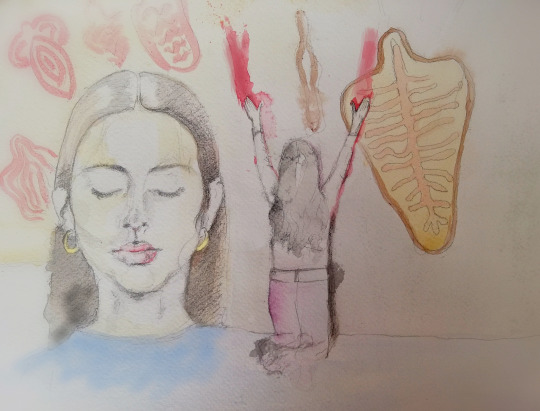
Ana Mendieta
Ilustración de MªJosé Molina Sierra
¿Porqué comenzar una serie de ilustraciones dedicadas a mujeres artistas con la artista cubana Ana Mendieta?
Ana Mendieta pertenece a esa generación de artistas que entre los años 70 y principios de los 80, promulgarán la caída de los estereotipos propios de la sociedad burguesa occidental, cuestionándose las propias estructuras de la institución artística. Valdría subrayar entre otros aspectos relacionados con su participación en el llamado proceso de deconstrucción crítica del objeto artístico, la disolución del carácter objetual de su obra en favor de una mayor incidencia en el proceso de construcción de la misma, la utilización de su cuerpo y del paisaje como territorio de exploración, la participación del público, así como su compromiso político con los principales movimientos vinculados a los derechos civiles, surgidos en Estados Unidos en la década de los 60. A pesar de todo eso, a pesar de la relevancia de su obra y a diferencia de la de sus colegas hombres, la obra de Mendieta, no está en los museos.
Infancia en Cuba
Ana Mendieta nació en La Habana en 1948, pero abandonó Cuba con doce años tras el triunfo de la revolución. Ana y su hermana mayor Raquel fueron parte de la operación Peter Pan, exiliadas en 1961 gracias a una maniobra del gobierno americano, que con el apoyo de la iglesia católica cubana sacaron de la isla a más de 14.000 niños y adolescentes entre seis y dieciséis años, en uno de los mayores éxodos de niños de la historia reciente. Ante el temor de un posible adoctrinamiento marxista, la familia de Ana Mendieta, perteneciente a la oligarquía cubana, consideraron conveniente enviarlas a Estados Unidos, confiando que la revolución no triunfaría y que la separación no se prolongaría. Aunque la realidad fue bien distinta y tuvieron que esperar trece años para volverse a reunir.
Exilio y desarraigo
A su llegada a Estados Unidos, Ana y Raquel fueron trasladadas desde Miami a Iowa donde sin parientes cercanos ni familia, quedarán bajo la tutela de diferentes organizaciones caritativas católicas. Fueron años muy duros para las dos hermanas, que hasta su mayoría de edad recorrieron diferentes centros y familias de acogida. Unas niñas procedentes de una familia de origen español, hasta entonces no se habían cuestionado ni su raza, ni su identidad, pero las experiencias racistas sufridas a su llegada a Estados Unidos, cambiarán radicalmente la percepción sobre sí mismas (Blocker, 1999) y fueron determinantes para Ana, que a la postre se identificará como una mujer de color.
Arrancada de su familia, empujada a abandonar Cuba y obligada a pasar su adolescencia de orfanato en orfanato, el exilio y el desarraigo se han entendido como una de las claves para la interpretar su obra: “Ana tenía una idea muy especial acerca de la tierra como la concepción concreta de patria” (Nancy Morrejón, documental Fuego de Tierra, 1987).
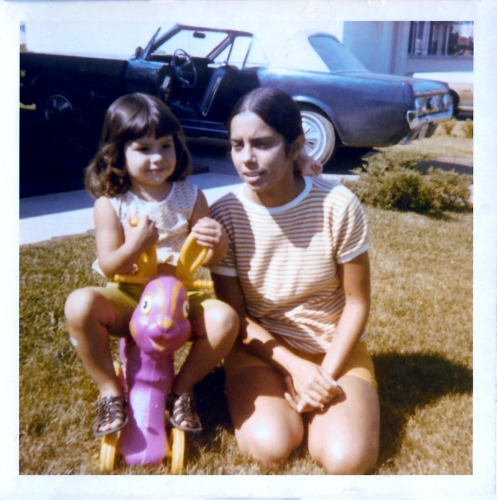
Ana fotografiada junto a su sobrina Raquel Cecilia Mendieta, cineasta y autora del documental sobre Ana Mendieta, Whispering Cave (English, French subtitles).
Etapa universitaria en Iowa
En 1966, cinco años más tarde, su madre se traslada a Iowa para instalarse junto a sus hijas, mientras que su padre permanece encarcelado en Cuba. Tanto Ana como Raquel comenzaron a cursar estudios en el Departamento de Arte de la Universidad de Iowa, donde Ana se gradúa poco después. Es durante su etapa universitaria, cuando la Ana Mendieta se involucra con el movimiento feminista y realiza algunas de sus primeras performances.
La sangre se convierte en una constante en su etapa universitaria, cuando realiza performances que denunciaban la violencia contra las mujeres como “Untitled. Chicken Piece” (1972), “Sweeting blood” (1973), “Blood writting” (1974), “Blood track” (1974) [5] o “Rape Scene” (1973), la más explícita de todas ellas y en relación a la cuál la artista Nancy Spero explica: “es una expresión política, no sólo una expresión artística, de cómo se sentía acerca de la violencia y la vulnerabilidad del cuerpo de la mujer” (Nancy Spero, documental Fuego de Tierra, 1987). Aquí Ana se basa en un hecho real sucedido en el Campus de la Universidad y reconstruye la escena de la violación y el asesinato de una estudiante, poniéndose en el papel de la víctima. La artista permanece en su estudio inmóvil durante una hora, desnuda de cintura para abajo, cubierta de sangre y rodeada de platos rotos y huellas de sangre.
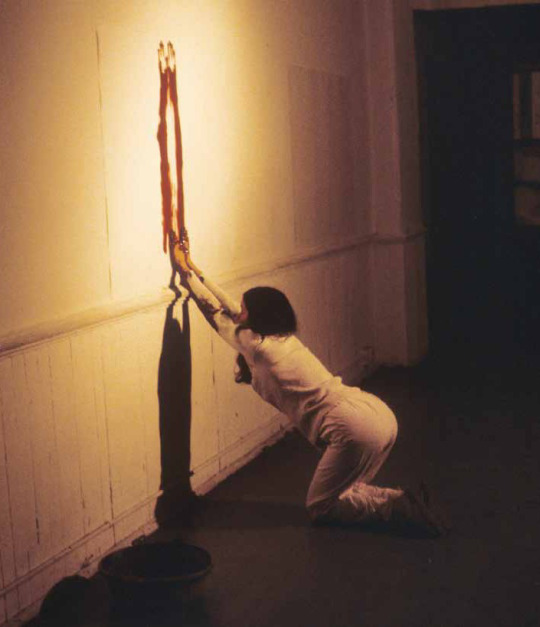
Blood track (1974) © The Estate of Ana Mendieta Fotografía: Cortesía de la Galería Lelong, Nueva York
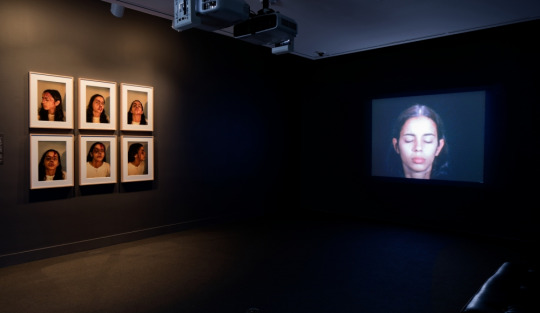
Exposición Covered in Time and History: The Films of Ana Mendieta
NSU Art Museum Fort Lauderdale, Florida
February 28 – July 3, 2016

Untitled (Cosmetic Facial Variations), 1972 / 1997
Suite of four color photographs 16 x 20 inches (40.6 x 50.8 cm) each
Edition of 110
© The Estate of Ana Mendieta Collection, LLC. Licensed by Artists Rights Society (ARS), New York
Una nueva vida en Nueva York
En el año 1978 Ana Mendieta se traslada a Nueva York y allí se integra en los distintos grupos de arte feminista. Un año más tarde expone por primera vez en solitario, en una de las principales galerías vinculadas con el movimiento feminista, la Galería A.I.R, en la que también exponían artistas como Nancy Spero, Mary Beth Edelson o Mary Miss, entre otras.
Siluetas
Pero será el comienzo de su prolífica serie Siluetas, en 1973 , el que marcará un antes y un después en su carrera e influirá decisivamente en la evolución de su trabajo. En adelante Mendieta aborda una serie de proyectos creados en la naturaleza que la artista recupera a través de grabaciones y sobre todo fotografías, que se convierten en el recuerdo de la acción y eventualmente, en la obra definitiva, una vez en la galería. Entre 1973 y 1980 Ana Mendieta realiza más de cien ‘Siluetas’ en lugares aislados.
En las primeras, la artista participa con su propio cuerpo, -este es el caso de su silueta “Imagen de Yagul” en la tumba de Zapotec en Oaxaca, realizada en uno de sus sucesivos viajes a Méjico en 1973, a partir del cuál arranca la serie ‘Siluetas’-, para ir sucesivamente alejándose de la presencia personal.
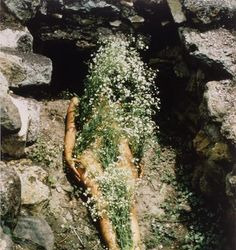
Imagen de Yagul, silueta en la tumba de Zapotec en Oaxaca (1973) © The Estate of Ana Mendieta Fotografía: Cortesía de la Galería Lelong, Nueva York
En sus posteriores ‘Siluetas’ Ana desaparece y se limita a dejar su huella sobre la tierra. Algunas consisten en figuras modeladas sobre el paisaje formando un pequeño montículo de diversos materiales como barro, ramas, hierva, pigmento, polvo, nieve o hielo. En otras versiones la artista excava la tierra formando una suave depresión o amontona flores, ropas, palos, rocas o conchas creando formas figurativas. La obra “Sin título” incluida en la colección del Centro Andaluz de Arte Contemporáneo de Sevilla, sería un ejemplo de la ausencia voluntaria de la artista y de la desaparición del objeto artístico llevada al extremo. Se trata de una forma esquemática, aparentemente simbología, realizada a las afueras de la ciudad de Iowa en 1980. En ella, Mendieta modela en la tierra una forma estilizada que evoca la silueta femenina –algo que se repite obsesivamente en muchos de sus dibujos y otras esculturas de esta época–, muy próxima a los genitales de la mujer, que luego perfora con un orificio a modo acanaladura. Como en otras ocasiones, la artista utiliza esta oquedad para llenarla de pólvora que deja luego quemar hasta que solo quedan las cenizas.
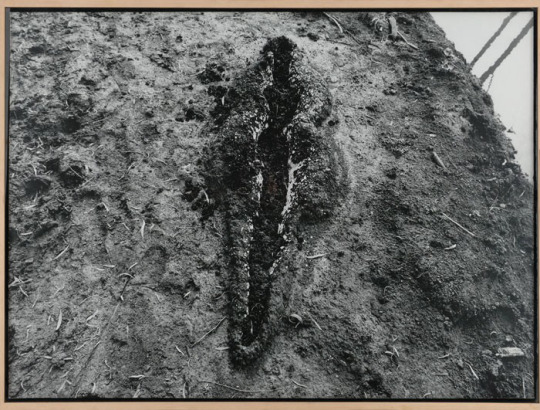
Sin título, (1980) Serie Silueta, Nº Edición 2/6 100,5 x 135,5 cm. Centro Andaluz de Arte Contemporáneo, Sevilla
Mendieta reutiliza un año más tarde la imagen de esta silueta en su proyecto para la revista de arte feminista Heresies bajo el título La Venus Negra. La artista acompaña la fotografía de la silueta, del relato de una leyenda cubana del S.XIX sobre una misteriosa joven que se negó a ser esclavizada por los primeros conquistadores españoles que pisaron la costa cubana de Cayo Loco, cerca de la ciudad de Cienfuegos, alrededor de 1817. Estos primeros hombres blancos en llegar a la costa sur de Cuba solo encontraron una habitante, una mujer negra bellísima, totalmente desnuda, descendiente de Indios Siboney, a la que dieron el nombre de La Venus Negra. La joven fue llevada a casa de uno de ellos, pero arrebatada de su tierra, se negó a comer hasta que, ante el temor de que muriese de inanición, fue devuelta a Cayo Loco para que viviese en libertad. A lo largo de los años los habitantes de Cienfuegos intentaron civilizarla, pero ella se negó a vestirse o a comer nada que no procediese de su entorno, como era la yuca, el plátano o la batata. La Venus Negra se convirtió en un símbolo contra la esclavitud para el pueblo cubano. Para la escritora Jane Blocker, Ana traslada aquí el mito a su concepto de tierra o patria y lo asocia con el pueblo indígena sometido por el hombre blanco y con la imagen de la mujer negra, haciendo referencia al fenómeno de la diferencia de la mujer de color, con la que ella se siente identificada. (Blocker, 1999)
La influencia prehispánica y africana
Ya en sus comienzos en Iowa la artista mostró un gran interés por las culturas prehispánicas, africanas y por la santería cubana y desde su llegada a Nueva York mantendrá una fuerte relación con la comunidad de artistas latinos afincados en la ciudad. Explica su amigo el artista puertorriqueño Juan Sánchez, que como muchos de ellos, Mendieta se declaraba heredera de la cultura africana y tenía una fuerte identificación con deidades africanas como el Changó, el Mobatalá o el Llamala, a las que trató de hacer converger en su obra para que dieran “más fuerza y energía a su trabajo”. (Juan Sánchez , documental Fuego de Tierra, 1987).
Los libros Leyendas Cubanas de Salvador Bueno y Mitología y artes prehispánicas de las Antillas de José Juan Arrom´s fueron su fuente de inspiración y a ellos acudirá para llevar a cabo la más ambiciosa de sus series de esculturas (Clearwater, 1993).
Esculturas Rupestres
“Me contó, quiero hacerme aquí, porque yo nací aquí en Cuba y quiero dejar todos mis sentimientos y mis espíritus en este lugar” (Nancy Morrejón, documental Fuego de Tierra, 1987)
Ana vuelve a Cuba por primera vez después de muchos años, en 1980. Al año siguiente decide regresar y encontrarse con su tierra. Inspirada en la iconografía de la cultura prehispánica de los Taíno, esculpió en el verano de 1981 en las paredes de dos grutas del Parque nacional “Escaleras de Jaruco” cerca de la Habana, una serie de grandes figuras femeninas que titula con nombres de diosas que recupera de sus fuentes bibliográficas: “Atabey” (Diosa protectora de las Aguas), “Guanaroca” (La Primera Mujer), “Guabancex” (Diosa del Viento), “Maroya” (La Luna), “Iyare” (La Madre), “Alboboa” (La Belleza Primera), “Bacayu” (La Luz del Día), “Guacar” (Nuestra Menstruación) e “Itiba Cachubaba” (La Vieja Madre Sangre).
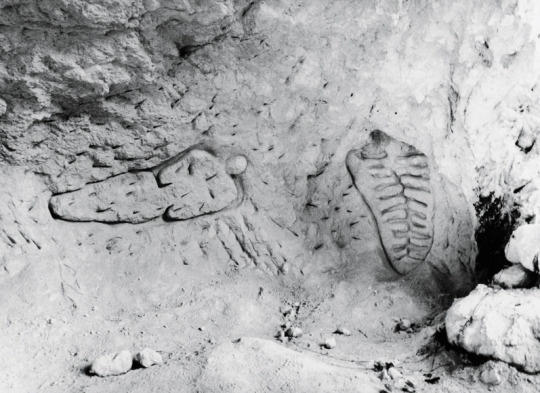
Ana Mendieta
Untitled (Esculturas Rupestres), 1981
[Rupestrian Sculptures]
Black and white photograph
7 x 9.75 inches (17.8 x 22.9 cm)
El acceso a las cuevas era muy dificultoso, así que Ana concibe el proyecto a modo de libro donde recopilar las fotografías de sus esculturas, de tal manera que éstas transmitiesen la magnitud del trabajo. Ana explica en sus notas: “(...) como cubana, americana y heredera de la cultura Taína, quiero hacer una pequeña publicación, una colaboración podría decirse, entre ellos y yo, usando sus mitos y mis dibujos” (notas para el libro A book of drawings). El proyecto del libro no saldrá a la luz hasta años después, bajo el título de “Ana Mendieta: A book of works”. Terminado el trabajo, las esculturas quedarán olvidadas, hasta que siete años más tarde el equipo del documental “Ana Mendieta: Fuego de Tierra” regresa a la cuevas, pudiendo comprobar como la naturaleza había hecho su trabajo y como aquellas formas ligadas al cuerpo de la mujer habían ido transformándose.
Ana esculpió su obra sin descanso, según su amigo el crítico de arte cubano Gerardo Mosquera en “una especie de comunión con la tierra cubana” (Fuego de Tierra, 1987) y en lo que ella misma describió en sus notas como en “un acto de comunión íntima con la tierra, una vuelta al amor de los brazos de una madre” (notas para el libro A book of drawings). Para Mosquera esto era precisamente lo que perseguía la artista “(...)ya que Ana pretendía que la obra fuera parte de la naturaleza, como símbolo de ella misma, siendo parte de esta, trasformándose con ella(...)” (Fuego de Tierra, 1987)
Su trágica muerte
Cuatro años después, el 8 de Septiembre de 1985, a los 36 años de edad, Ana Mendieta cae desnuda desde el piso 34 de su apartamento en Manhattan, truncándose una fugaz, pero fulgurante carrera artística. Las circunstancias que rodearon su muerte fueron extrañas. Su marido, el conocido artista minimalista Carl Andre, con quién Ana Mendieta se había casado pocos meses antes, la acompañaba. Supuestamente ambos habían mantenido una acalorada discusión aquella noche, y André argumentará que la artista se suicidó arrojándose desde la ventana. Sin embargo su hermana Raquel Mendieta y el resto de la familia y amigos defenderán en un juicio que Andre empujó aquella noche a su mujer, asesinándola. En Febrero de 1988, tres años más tarde del trágico acontecimiento, Andre será absuelto de los cargos de asesinato.
“Carl Andre está en el Guggenheim. ¿Dónde está Ana Mendieta?”
En Junio de 1992 coincidiendo con la apertura de la nueva sede del Guggenheim en el SoHo de Nueva York, un grupo de manifestantes se convocaron a las puertas del museo para denunciar que de los cinco artistas invitados a la exposición inaugural, cuatro fuesen hombres y de raza blanca, exigiendo una mayor presencia de las mujeres en las instituciones culturales. Entre los manifestantes, un grupo formado por Raquel Mendieta, Josely Carvalho, Juan Sánchez, Mañuel Pardo, Joey Silverman y Lucy Lippard entre otros, ataviados con camisetas y armados de una pancarta, denunciaban lo que para ellos era la otra gran injusticia: que el artista Carl Andre fuese uno de los elegidos. “Carl Andre is in the Guggenheim. Where is Ana Mendieta?¿Dónde está Ana Mendieta?” rezaba el rótulo de la pancarta. Indudablemente todos sabían donde estaba Andre, la pregunta incomoda era donde estaba Ana Mendieta (Blocker, 1999). Y es que resultaba una afrenta que, mientras Andre exponía en el Guggenheim, Ana Mendieta –después de haber tenido reconocimiento internacional y de años de lucha feminista- estuviese “desaparecida”.
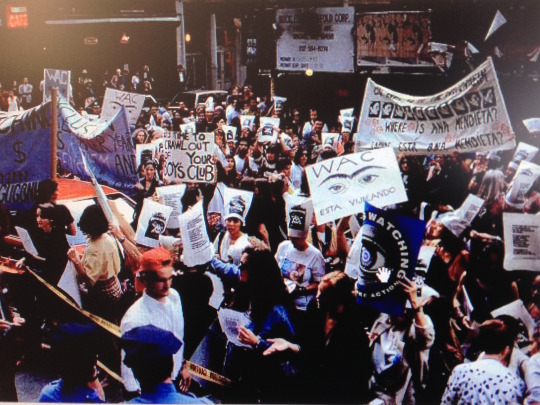
Protesta de Women´s Action Coalition (WAC) frente al Museo Guggenheim, Nueva York, 1992.
Afortunadamente la política de los museos comenzó levemente a cambiar en la década de los noventa, tanto en Estados Unidos como en Europa y artistas como Ana Mendieta, que se movieron en los márgenes del sistema hegemónico de poder, empezaron a tener acogida en las colecciones y exposiciones de los grandes museos. Prueba de ello, que en 1989 el New Museum of Contemporary Art de Nueva York dedicó a Ana Mendieta una exposición retrospectiva.
Para concluir, ante preguntas como: ¿Son necesarias las llamadas políticas con perspectiva de género en los museos? ¿Es preciso que las instituciones culturales se comprometan por un adecuado tratamiento del concepto de género en las salas de los museos? ¿Son necesarias genealogías femeninas, muestras colectivas o revisiones como las que nos hemos propuesto trazar en estas líneas, dedicadas a mujeres artistas? Nuestra respuesta sería sí, indudablemente y hoy en día más que nunca, son imprescindibles.
Frente aquellos que todavía se cuestionan la necesidad de las llamadas políticas de igualdad, podríamos afirmar que ha sido precisamente gracias a la voluntad real por parte de instituciones culturales como en Andalucía el Centro Andaluz de Arte Contemporáneo por hacer visibles a las mujeres artistas y gracias sobretodo, a la lucha política de muchas de ellas, que el desequilibrio entre los sexos se ha atenuado en las últimas décadas. Pero no cantemos victoria, todavía queda mucho por hacer en aras de “modificar el carácter androcéntrico de los museos” (López Fernández Cao, 2011).
#artefeminista#AnaMendieta#bodyart#artland#nancy spero#Centro Andaluz de Arte Contemporáneo#mary beth edelson#mary miss
16 notes
·
View notes
Text
#luna realty belize#belize real estate#belize property for sale#ambergris caye#waterfront property with stunning views for sale#cayo real estate#secret beach belize
0 notes
Text
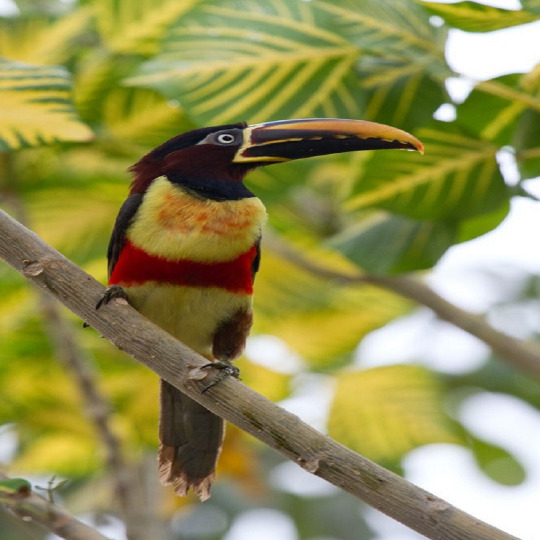
Unlock Cayo's Real Estate Potential
Discover a world of opportunity with Cayo Belize real estate. Immerse yourself in the vibrant visuals of lush landscapes, tranquil rivers, and exquisite properties. At RE/MAX Belize Property Center, we showcase the diversity and beauty of Cayo real estate prices, offering investment options for every budget. Explore with us today!
0 notes
Text
Stock Analysis: PJAA
PT Pembangunan Jaya Ancol Tbk (PJAA) masuk ke dalam watchlist saya karena memiliki dividend yield 19.81% (berdasarkan dividend tahun lalu). Tentu saja cukup impresive. Namun, bagaimanapun saya tidak bisa percaya begitu saja dengan asumsi tahun lalu ini. Terlebih dengan wabah pandemi yang saat ini sedang terjadi dimana PJAA bergerak dibidang wisata, dan sektor wisata termasuk dalam sektor paling terpengaruh oleh pandemi ini. Tetapi, saya ingat kembali tentang prinsip The Second Level Thinker: seberapa terpengaruh PJAA dengan pandemi ini? Apakah koreksi pasar sudah memberikan peluang?
Lets see..
PJAA bergerak di sektor trade dengan domain industri Restoran, Hotel, dan Pariwisata. Produk atau service yang menjadi kunci dari emiten ini adalah Taman Impian Jaya Ancol (TIJA). Key factor dari pendapatan perusahaan sudah dapat dipastikan dari wisatawan TIJA itu sendiri. Pemilik saham terbesar adalah Pemerintah DKI Jakarta (72%) dan saham yang dimiliki oleh publik sebesar 9.99%.
Mari kita lihat lebih detail dengan impact COVID-19 kepada pendapatan perusahaan. Merujuk ke laporan keuangan, PJAA membagi pendapatan kedalam empat segmen: Real Estate, Ticket, Hotel & Resto, Other. Dari revenue stream tersebut, ada dua yang terdampak sangat besar dari pandemi, yaitu Ticket (Gerbang & Wahana) dan Hotel & Resto. Kedua segmen ini menyumbang 79.3% sendiri dari total pemasukan. Komposisi pemasukan per segmen ini tidak jauh berubah dari tahun 2019 dan 2018.
Berikut gambaran prosentase pendapatan per segmen tahun 2019
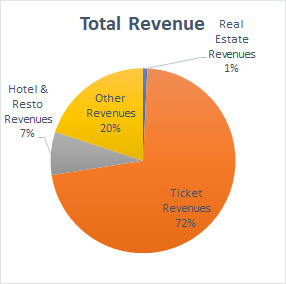
Dengan estimasi konserviatif, dimana penutupan TIJA dimulai pada pertengahan maret lalu dan efek dari pandemi akan berahir di pertengahan September (semoga lebih cepat, aamiin ya Allah). September menurut hemat saya, bukan berarti bahwa pandemi baru akan berakhir di September, tetapi saya estimasikan sampai September karena efek ekonomi dari pandemi ini tidak serta merta menyebabkan orang mau berwisata kembali ditengah ekonomi yang sedang krisis. Sehingga ada jeda waktu dimana orang-orang berwisata kembali sehingga September menurut saya adalah estimasi yang sudah cukup aman. Maka emiten akan kehilangan 6 bulan sehingga paling tidak pendapatan dari segmen yang terdampak akan berkurang 50% dalam setahun, dengan estimasi pendapatan tiap quarter memiliki kontribusi yang sama. Meskipun pada laporan perkuartal dapat terlihat bahwa di kuartal ke empat pasti memliki peningkatan, ya karena banyak liburan. Tetapi saya anggap merata saja sepanjang tahun, sekali lagi, demi azaz kenservatif. Selain itu, karena other revenues memiliki kontribusi yang cukup signifikan (20%), maka saya rasa perlu menelisik lebih detail. Dari laporan keuangan didapatkan komposisi other revenues adalah sebagai berikut:
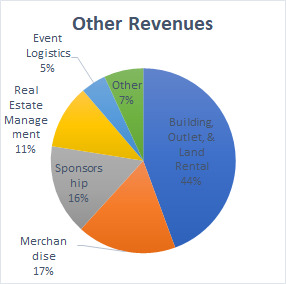
Jika dilihat ke grafik, maka penjabaran dari other revenues malah semakin membuat ketakutan, dimana hampir semua sub segmen tersebut terdampak dari efek pandemi ini.
Daripada pusing-pusing menerka-nerka kembali seberapa besar dampak yang diterima dari segmen-segmen tersebut, maka biar lebih gampang, kita langsung cut saja pendapatan PJAA 50% karena sisa segmen yang mungkin tidak terdampak adalah Real Estate Revenues yang hanya menyumbang 1% dari total pendapatan. Dwar!
Pertanyaan berikutnya adalah, berapa Net Income yang didapatkan jika pendapatan akan menghilang 50%?
Untuk menjawab pertanyaan tersebut, saya rasa kurang njlimet jika langsung dikali 50% dari prediksi Net Income tahun depan dalam kondisi normal (tanpa pandemi). dan tentu hasilnya akan sangat ngaco! Seharusnya hal ini dapat dianalisa jika PJAA menyajikan lebih detail terkain margin laba dari setiap segmen di laporan keuanga, tetapi sayangnya di laporan keuangan hanya disajikan beban keuangan yang sudah dikonsolidasi secara keseluruhan. Tetapi tidak apa-apa. Kita tetap harus berjuang menerkanya. Cayo!
Langkah pertama adalah mengidentifikasi dari tiap-tiap beban keuangan yang ada. Kemudian memberi skor efek dari tiap-tiap post mengacu pada kebijakan perusahaan menutup TIJA dengan estimasi sampai September.
Begini penampakannya

Tentunya, ini sangat disederhanakan sehingga seharusnya lebih njlimet lagi jika mengacu plek sesuai dengan laporan keuangan. Tetapi menurut hemat saya, ya itu saja yang perlu saya masukkan karena untuk post-post lain seperti saya pusing sendiri menganalisanya.
Oiya, ngomong-ngomong untuk soal Effect Ratio, itu berdasarkan analisa saya saja dimana saya kira-kira tiap post bagaiaman dampak yang timbul dari penutupan TIJA selama 6 bula. Sebagai contoh dimana cost revenue merchandise pasti akan ikut berkurang seiring dengan penjualan merchandise yang juga berkurang, maka saya beri skor 50%. Untuk direct cost, saya berikan skor 75% karena di penjabaran cost tersebut, terdapat beberapa yang ikut terdampak dan ada yang tidak. Jadi ya saya kira-kira 75%. Begitu seterusnya.
Begitu juga untuk revenues saya simulasikan dengan penampakan sebagai berikut:
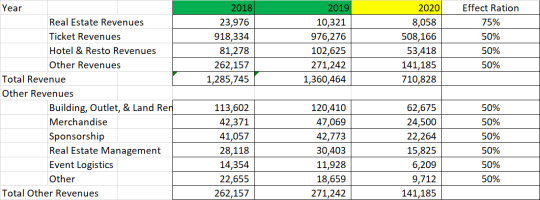
Oiya, untuk forecast tahun 2020, saya gunakan pengali growth rata-rata dari kenaikan setiap tahun selama 10 tahun dari Net Income sehingga didapatkan growth ratio untuk net income sebesar 4.1%. Ini didapat menggunakan rumus Log di excel saja.
Dari perikaraan-perkiraan yang rada ngawur diatas, maka dilanjutnya memprediksi Net Income PJAA dengan penampakan sebagai berikut:

Untuk Tax, saya perkirakan dengan acuan kepada revenues, dimana didapatkan kurang lebih besaran tax itu 0.95% dari total revenue. Ngawur lagi ini rumusnya sih. Hahaha.
Dari hasil simulasi tersebut, maka didapatkan bahwa PJAA akan merugi cukup besar di 2020. Tetapi...
Yes, memang tidak plek. Dimana Net income tahun 2018 dan 2019 tidak sama dengan aktual yang dilaporkan oleh perusahaan, beda-beda tipis lah. Ini karena beberapa faktor saya abaikan. Termasuk perbedaan kurs. Ini mungkin juga akan berdampak besar karena kenaikan dollar begitu menggila tahun ini. Jadi, mungkin kerugianya bisa jadi lebih besar.
Namun demikian, apakah dengan kerugian tersebut perusahaan kemudian game over? Saya rasa tidak Ferguso.
Jika dilihat di balance sheet, maka perusahaan memiliki kas atau setara kas sebesar 478 Miliar dan Net Income sebanyak 221 Miliar yang dapat digunakan untuk bernafas selagi kondisi ekonomi kembali normal. Pada sepuluh tahun terahir, PJAA selalu membagikan deviden dengan Payout Ration tidak pernah kurang dari 30%. Mungkin saja tahun ini PJAA tidak akan membagikan dividend sehingga tetap dapat mencukupi capex dan opex ditahun berikutnya.
Walau bagaimanapun, PJAA adalah emiten yang cukup bagus dan konsisten membagikan dividend. Mengacu pada historical data berikut
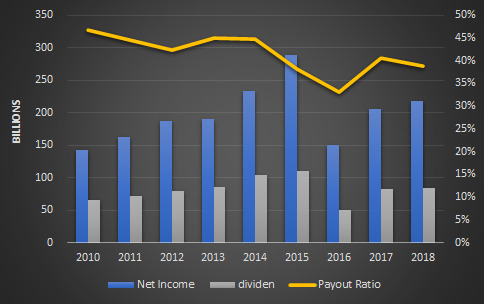
Maka terlihat bahwa pembagian di periode yang akan datang cenderung untuk terus naik meskipus secara payout ratio memiliki kecenderugan turun.
Dari sisi Debt dan Equity, PJAA juga tetap konsisten bisa mempertahankan kecenderungan kenaikan equity meskipun DER semakin hari semakin menggelisahkan
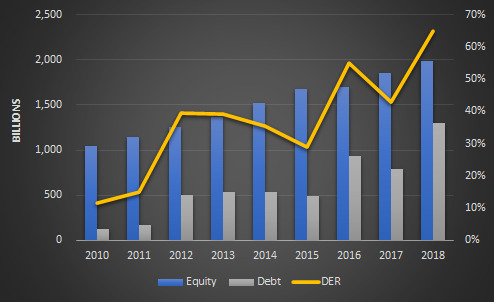
Lastly, saya menduga seperti pada hasil simulasi saya diatas bahwa PJAA akan mengalami kerugian di tahun 2020. Namun demikian, mengacu pada track record perusahaan sepuluh tahun terahir, saya percaya bahwa PJAA di tahun-tahun berikutnya akan kembali kepada track-nya untuk terus konsisten dapat membagikan dividend dan menjaga pertumbuhan equity-nya. Mungkin saat kondisi terjatuh di tahun ini, bisa menjadi peluang langka jika harga dari PJAA terkoreksi cukup dalam sehingga bisa menabung sambil menunggu perusahaan kembali on track setelah pandemi ini berahir.
Cheers!
Declaimer: Tulisan ini hanyalah catatan pribadi saya dan bukan rekomendasi investasi untuk menjual ataupun membeli. DYOR! (Do Your Own Research).
2 notes
·
View notes
Text
5 Mind-Blowing Reasons Why Living in Southwest Florida is a Must
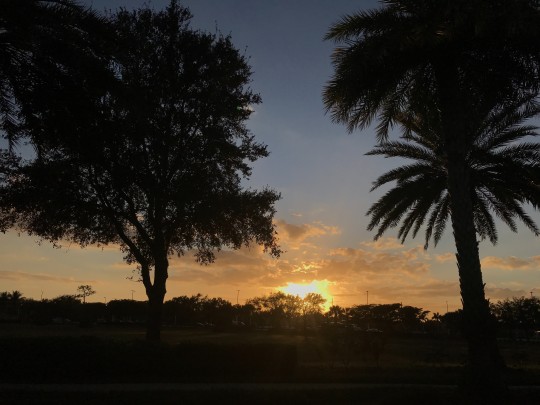
Welcome to the land of sunshine and happiness that is Southwest Florida. Located off the southern half of the gulf coast, come explore, take in, and be a part of a region nestled between some of the country’s most dynamic beaches and nature preserves. Ever wondered what it would be like to live in paradise? Well keep reading to see why thousands of people for generations have flocked to this hidden gem and now call Southwest Florida home.
#1 Climate
Southwest Florida boast some of the country’s most spectacular weather, especially during the winter season, with the average temperature hovering at 75 degrees. The summer months remain relatively warm with average summer temps climbing to the low 90s, along with afternoon showers that quickly dissipate to bring forth beautiful sunsets. With bountiful sunshine and the breeze from the gulf, this makes sitting on the lanai, or basking on the beach possible all year round.
#2 Natural Beauty & Wildlife
Explore the natural beauty that encompasses and surrounds Southwest Florida. From the exceptional landscape of the Everglades, to the many nature preserves, and state parks that are home to unique wildlife and a variety of birds that inhabit the land. If you’re looking for your next big catch, then look no further because Southwest Florida’s got you covered. Whether your deep-sea fishing off the coast or casting your line off the fantastic Naples Pier, the fish are sure to be biting.
#3 Beaches
Miles of breath-taking shorelines await your presence here in Southwest Florida. Immerse yourself on the Islands of Sanibel and Captiva, or discover the beauty of Bonita, Fort Myers, or Naples beach. Whatever your pleasure let the warm waters and tranquility take you away. Delight in walking alongside glistening water with the warm sand between your toes on some of Florida’s award-winning beaches.
#4 Proximity to Other Cities
Location is everything, and Southwest Florida has it. The heart of Southwest Florida is anchored by the “City of Palms” which is Fort Myers. It is closely surrounded by a variety of other cities and towns including Naples, Cape Coral, Estero, Bonita Springs, and Ave Maria. Wherever you land in Southwest Florida you are never to far from experiencing all that Florida has to offer. With drives to destinations like Miami, Tampa, Ft. Lauderdale, and Sarasota all within a few hours reach, you’ll never be far from entertainment and fun across the Southern Florida Peninsula.
#5 Outdoor Activities
With Sunshine always at your fingertips, take advantage of the many adventures that Southwest Florida has to offer. Enjoy kayaking down one of our many canals, taking an airboat ride through the famous Florida Everglades, walking the scenic grounds of the Historic Edison Ford Estates, or go shelling on the magnificent Marco Island. Southwest Florida is also home to several stunning State Parks. Take pleasure in snorkeling at Cayo Costa, boating at Delnor-Wiggins Pass, or go hiking in the Estero Bay Preserve. Don’t worry if nature isn’t for you, we have fantastic outdoor shopping at our Miromar Outlets and Coconut Point Mall for your enjoyment.
Southwest Florida invites you to visit, but we would love to welcome you home!
Are you considering making SouthWest Florida your home ?
Contact Devon Artis Realtor with The Simonelli Real Estate Group
1 note
·
View note
Text
The Booming Real Estate Market in Belize: An Overview of Opportunities and Trends
Introduction: Belize’s real estate market has been experiencing significant growth in recent years, attracting both local and international investors. This article provides an in-depth overview of the booming real estate market in Belize, highlighting the opportunities and trends that make it a lucrative investment destination.
Factors Driving the Market Growth: Explore the factors fueling the growth of the real estate market in Belize, such as the country’s political stability, attractive investment incentives, and its reputation as a prime tourist destination. Additionally, the government’s efforts to streamline property acquisition and enhance investor confidence have played a pivotal role in attracting real estate investors.
Diverse Property Options: Discover the diverse range of property options available in Belize Real Estate, including beachfront villas, luxury condos, residential homes, and investment properties. Each region offers unique characteristics and attractions, allowing investors to choose from a variety of locations that suit their preferences and investment goals.
Investment Opportunities: Learn about the different investment opportunities in Belize’s real estate market, such as rental properties, vacation homes, and commercial ventures. Explore the potential returns on investment, rental income possibilities, and long-term appreciation of property values in various regions across the country.
Legal Considerations: Understand the legal framework for purchasing and owning real estate in Belize. This section covers topics such as property ownership regulations, residency requirements, taxes, and the process of acquiring property as a foreign investor. Having a clear understanding of the legal aspects is essential for a successful real estate investment in Belize.
Regions with Promising Growth: Explore the regions in Belize that are experiencing rapid development and are poised for growth. Discover the emerging hotspots, such as Ambergris Caye, Placencia, and Cayo District, which offer attractive investment opportunities due to their natural beauty, tourism potential, and infrastructure development.
Sustainable and Eco-Friendly Real Estate: Belize is known for its commitment to sustainable development and eco-tourism. Learn about the growing trend of sustainable and eco-friendly real estate in Belize, including green building practices, solar-powered homes, and environmentally conscious communities. Investing in eco-friendly properties not only benefits the environment but also attracts environmentally conscious travelers and tenants.
Challenges and Risks: While the Belizean real estate market offers numerous opportunities, it’s important to be aware of the challenges and risks associated with investing in the country. This section covers potential pitfalls such as fluctuating market conditions, title and ownership issues, and the importance of conducting thorough due diligence before making a purchase.
Conclusion: Belize’s real estate market is flourishing, presenting a wide array of investment opportunities for both local and international buyers. By understanding the market trends, legal considerations, and regional growth prospects, investors can make informed decisions and capitalize on the potential of Belize’s booming real estate market.
1 note
·
View note
Link
0 notes